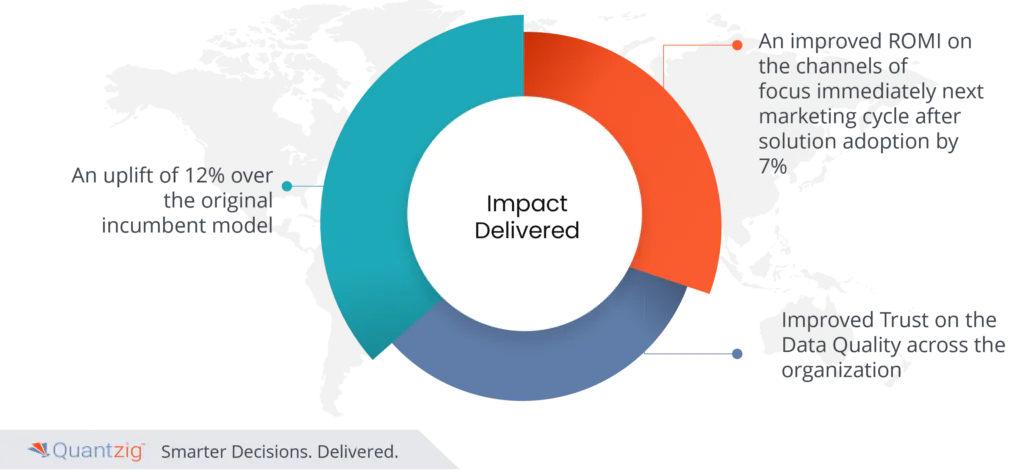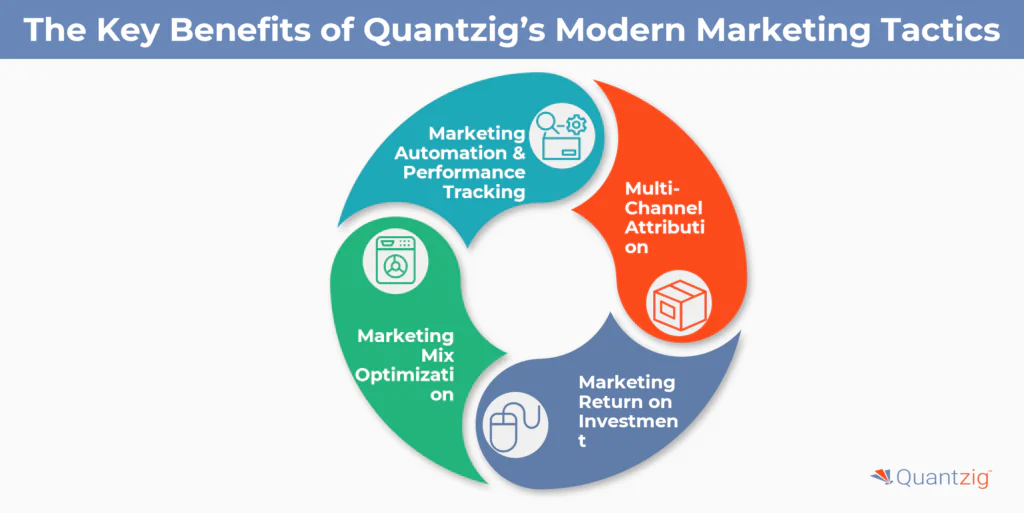Written By: Sudeshna Ghosh
Table of Contents
Key Takeaways for Modern Marketing Tactics
- Quantzig’s advanced MMM + MTA solution helped a US-based CPG company achieve an uplift of 12% over the original incumbent model, and to improve ROMI on the channels of focus immediate next marketing cycle after the solution adoption by 7%.
- The emergence of diverse digital and physical channels necessitates an integrated marketing framework to strategically optimize budgets and respond tactically to market risks and opportunities, ultimately maximizing Return on Marketing Investment (ROMI) for CMOs.
- Quantzig’s Unified Marketing Decision Management (MDM) assists the clients in determining expected revenue without promotional efforts, identifying which promotions are most effective in certain scenarios, allocating and reallocating promotional budgets, and defining efficient spending limits for each channel and promotion type.
Introduction
Nowadays, everybody knows that businesses can market their new products or services by posting many leaflets on their city signposts and signing up for eye-catching ads in the local newspapers. But do you know what benefits you can get from having some modern marketing tactics in your arsenal? Modern marketing strategy is the ability to harness the full potential of your business to provide the best experience to your clients and drive long-term sustainable growth. This case study will shed light on how Quantzig’s advanced MMM + MTA solution helped a US-based CPG company achieve an uplift of 12% over the original incumbent model, and to improve ROMI on the channels of focus immediate next marketing cycle after the solution adoption by 7%.
Book a demo to experience the meaningful insights we derive from data through our analytical tools and platform capabilities. Schedule a demo today!
Request a Free DemoQuantzig’s Modern Marketing Tactics for a CPG Brand
| Client Details | A CPG multinational client headquartered in the USA with a diverse product portfolio. |
| Challenges Faced by The Client | Their current MMM was more traditional and outdated with a once-a-year planning approach and the inability to provide dynamic plans for digital channels and leverage client internal marketing performance data into solutions. |
| Solutions Offered by Quantzig | Quantzig helped the client with the MMM + MTA solution with model refresh with newer weekly data. We began building the intelligence layer followed by attribution models for channels that did not have a direct way of recognizing the share of revenue. We then identified the sensitivities, and efficient boundaries for channel spending with ROI Measurements and enabled a simulation tool kit for marketing analysts to explore different budgeting scenarios and channel allocation. |
| Impact Delivered | 1. An uplift of 12% over the original incumbent model, and 2. An improved ROMI on the channels of focus immediately next marketing cycle after solution adoption by 7%. |
Client Details
A CPG multinational client headquartered in the USA.
Challenges in Modern Marketing Tactics Faced by the Client
The client is CPG Multinational with centralized budgeting and decentralized execution for Digital and non-digital channels. Their current MMM was more traditional analytics and outdated with a once-a-year planning approach and the inability to provide dynamic plans for digital channels and leverage client internal marketing performance data into solutions.
Modern Marketing Tactics Offered by Quantzig for the Client:
Quantzig helped the client with the MMM + MTA solution with model refresh with newer weekly data and thereby more adaptive plans to take into consideration of recency effect at any time of the year and not just at the start of the annual marketing cycle.
We began building the intelligence layer followed by attribution models for channels that did not have a direct way of recognizing the share of revenue. We followed it with the calculation of baseline revenue and breakdown of overall revenue for channel-wise spread. We then identified the sensitivities, and efficient boundaries for channel spending with ROI Measurements and enabled a simulation tool kit for marketing analysts to explore different budgeting scenarios and channel allocation.
Impact Delivered using Quantzig’s Expertise:

- An uplift of 12% over the original incumbent model, and
- An improved ROMI on the channels of focus immediately next marketing cycle after solution adoption by 7%.
- Improved Trust on the Data Quality across the organization.
Also Read: Maximizing Marketing Budgets with Campaign ROI Analysis
Get started with your complimentary trial today and delve into our platform without any obligations. Explore our wide range of customized, consumption driven analytical solutions services built across the analytical maturity levels.
Start your Free Trial TodayImportance of Modern Marketing Tactics for Organizations
Return on Marketing Investment (ROMI) is a crucial measurement that Chief Marketing Officers aim to enhance and maximize. With the rise of new digital and physical marketing channels, the ecosystem has become much more diverse, with many channel alternatives and flexible tactics for brands to connect with customers. An integrated marketing plan can assist in optimizing budgets strategically and responding to market hazards and prospects tactically.
What are the Potential Challenges While Implementing Modern Marketing Tactics for Organizations?
Marketing channels provide data in various formats with differing speed, quantity, and diversity. Consolidating this wide-ranging data into a cohesive strategy is a complex process requiring advanced analytics and machine – learning solutions. These solutions can programmatically identify, attribute, and recommend optimal investment plans for each channel.
What are the Key Benefits of Quantzig’s Modern Marketing Tactics for Organizations?
Quantzig’s Unified Marketing Decision Management (MDM) begins by comprehensively measuring and attributing marketing expenditures. It assists our clients in determining expected revenue without promotional efforts, identifying which promotions are most effective in certain scenarios, allocating and reallocating promotional budgets, and defining efficient spending limits for each channel and promotion type. Operationally,
- It provides marketing teams with integrated and targeted marketing strategies to cater to modern omnichannel customers.
- It also enables CMOs and marketing leaders to plan their next best expenditure with near real-time data across the calendar year, adjusting for seasonal performance and upcoming execution.
- It also enables digital marketers to respond to risks and opportunities faster with programmatic channel-specific action plans.
How does it work?
Our comprehensive solution assists in handling rapidly changing digital information, linking and assigning attribution for holistic insights, and driving real-time actionability across channels and platforms. This empowers adaptive consumer planning, spending allocation, and activation tactics tailored to the local category, market, brand, product, and hyper-personalized consumer personas. Our solution comprises the following 4 marketing optimization components:
1. Marketing Automation & Performance Tracking
2. Multi-Channel Attribution
3. Marketing Mix Optimization
4. Marketing Return on Investment Enhancement
Also Read: Track Business Progress with Marketing Analytics Dashboard
Experience the advantages firsthand by testing a customized complimentary pilot designed to address your specific requirements. Pilot studies are non-committal in nature.
Request a Free Pilot5 Modern Marketing Tactics You Should Know

1. Social Media Marketing
You should not be surprised to hear that social media marketing is a crucial first strategy in today’s digital landscape. Leveraging social platforms is essentially free and lets you spread awareness about your brand and offerings to a global audience with hyper-specific interests, with minimal effort. However, you must use social media effectively (provide value, don’t just promote) if you want to see results. Also, choose platforms that make the most sense for your business – consumer-focused ones like Facebook, Snapchat and Pinterest for B2C companies, and more professional ones like Twitter or LinkedIn for B2B.
On top of the basics, integrating tools like Views4You’s Story Viewer into your Instagram approach can really enhance your strategy. It’s like being a fly on the wall, observing what your competitors are doing with their stories, posts and reels, without them knowing. This inside look lets you stay on top of the latest trends and refine your own content accordingly to stay fresh, all without making a conspicuous move. It’s all about playing it smart – absorbing what’s happening around you to create content that truly resonates with your followers.
2. Email Marketing
Email marketing is still a great strategy in today’s digital age, as most individuals frequently check their inboxes throughout the day (or get alerts on their phones). Email differs somewhat from social media marketing in that it’s more useful for connecting with people who are already familiar with your brand, whereas social media is better for initially grabbing attention. In short, avoid sending unsolicited emails. Attempt to obtain the email addresses of prospective customers who opt-in to newsletters or gather from those who shared their contact info during prior purchases, then follow up tactfully and subtly for optimal outcomes.
3. Affiliate Marketing
Affiliate marketing is often viewed negatively online, but that’s due to the many “wantrepreneurs” who spam product links for profit. However, as a business you can start an affiliate program to motivate other website owners to promote your product in return for a commission on each sale they generate. If your product or service is valuable, and you offer attractive affiliate rates, many people will be eager to market your product on your behalf.
4. Internet Ads
Online ads are a form of “paid advertising” within the marketing field. You must pay money to utilize this marketing approach. In return for your hard-earned money, there are many online platforms that will display your ads for you. For instance, Google AdWords and Facebook Ads are two online ad platforms that let you show your products and services to very specific target audiences. They also provide more data about the performance of your ads than most other approaches. Furthermore, there are design tools to assist you when making your ads on these platforms, such as a Facebook Ad template. These tools can save you time when setting up your internet ad and make your ad appear more professional.
5. Product Placement
One more rising internet marketing tactic is to fund product placements in content creators’ material. Consider videos – many YouTube channels today are open to incorporating your product into their videos for a fee, provided it does not excessively irritate their viewers. Once more, if your product is stellar, this should not pose a problem.
To summarize, there exist various contemporary marketing approaches you can utilize to promote your business on the Internet. Ranging from social media to product placement.
Conclusion
In the digital age, organizations must adopt a customer-centric mindset and embrace modern marketing tactics to stay competitive. Leveraging generative AI and data analytics, they can effectively analyze customer behavior and preferences, enabling precise customer segmentation. Agile marketing methodologies facilitate swift adaptation to market dynamics, while affiliate marketing maximizes reach through strategic partnerships. Effective customer engagement hinges on understanding the entire customer journey and addressing pain points. Leveraging platforms like Facebook, Snapchat, Pinterest, Twitter, and LinkedIn diversifies outreach channels, optimizing internet ads for enhanced visibility.
Strategic organizational design fosters synergy between marketing operations and talent management, streamlining efforts for impactful results. Successful agency management ensures seamless collaboration for campaign execution. In conclusion, modern marketing thrives on innovation, agility, and a deep understanding of customer needs, paving the way for sustained growth and competitive advantage in the digital landscape.





